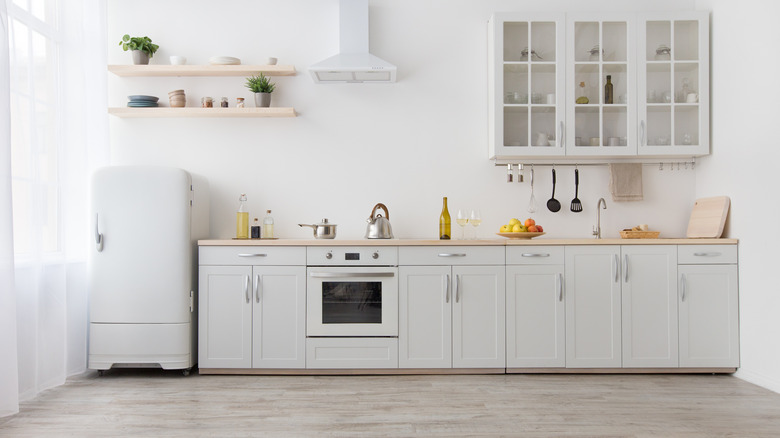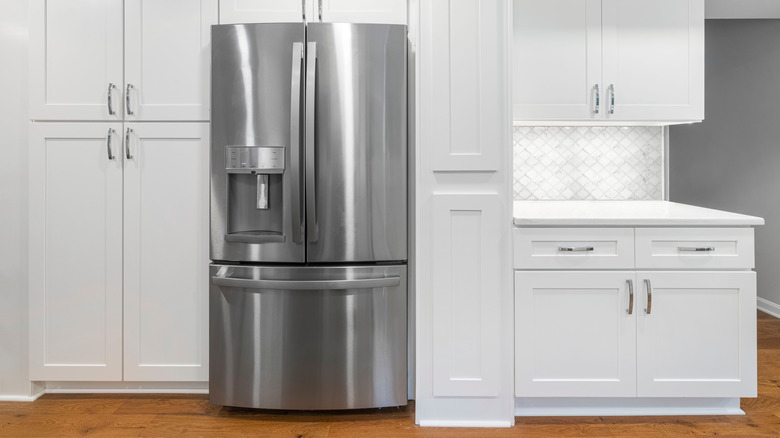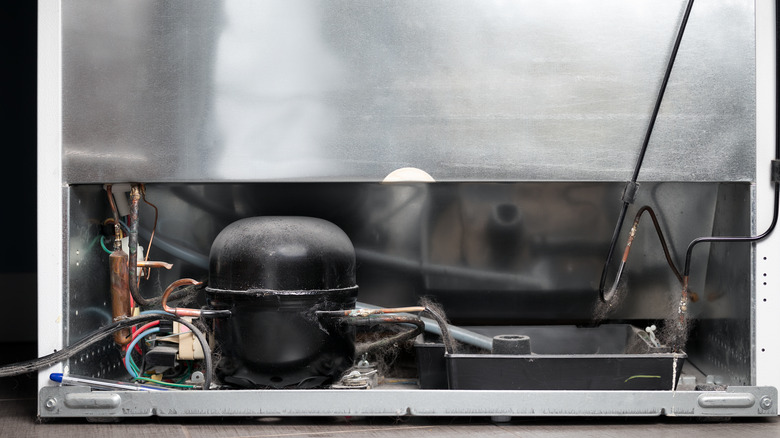The Best Way To Clean Behind Your Refrigerator
A French saying is, "Good food makes a beautiful figure," however, good food also leaves a mess in its wake, some of which ends up behind your refrigerator. Crumbs combined with dust, animal hair, mold, and pest remains are a health hazard and can compromise your appliance. The gunk is odor-causing and can be scattered by your family pet throughout your house, and it can attract mice, ants, and cockroaches.
According to McCombs Supply, it stands to reason that the back of your refrigerator should be cleaned and sanitized regularly, perhaps as often as four times a year. And do not limit your upkeep to just that space: The fridge's condenser coils need attention, and so does the wall behind the appliance and the floor underneath it. This maintenance is easy to overlook, and knowing you will have to move the refrigerator makes you want to delay it in any case. However, as confirmed by Fred's Appliance, the entire procedure can be accomplished in half an hour. Food will stay cold and won't even have to be taken out.
The Appliance Analysts estimate the average refrigerator is a 250-pound behemoth (300 if it has French doors). Nonetheless, it can be moved safely and relatively quickly to expose the area you need to clean. A minimum of cleaning supplies is required. The effort is well worth it for the health considerations, as well as avoiding the expense of replacing the refrigerator condenser since your fridge runs efficiently. A well-working refrigerator equals colder food and lower electric bills.
First things first: unplug the refrigerator
To access the area requiring cleaning, first, unplug the refrigerator and slowly pull it toward you and away from the wall. Hug the appliance and incrementally ease it straight ahead with knees slightly bent. According to Miss Spotless, moving it sideways can ding the floor covering, particularly vinyl, or damage the refrigerator itself. Step cautiously near the coils to avoid damaging them. The Dolly points out that most refrigerators have wheels to ease movement and protect the floor and the mover. Slipping a piece of cardboard underneath the fridge or using a slider implement can help. The cardboard can even sweep beneath the refrigerator to catch debris to be vacuumed afterward. Doing so proactively can reduce the frequency of a more substantial cleaning job.
Per McCombs Supply, a 50:50 solution of warm water and white vinegar will do wonders for the stained, greasy, and grimy wall backing the refrigerator. Don't ignore the now-exposed floorspace. Soapy water can also be used, spiked with a bit of baking soda or rubbing alcohol. Attack mold with a diluted combination of bleach and water, being sure to rinse well. Wearing gloves and a face mask is advisable. Thoroughly dry any surfaces before replacing your refrigerator.
Clean the condenser coils
Air passing over condenser coils cools your refrigerator. Unfortunately, the coils are a magnet for grime, dust, and hair and get encrusted over time. Dust-covered coils hinder your appliance's performance, and cleaning them is an essential part of refrigerator maintenance. Pulling out the refrigerator will allow you to access the coils. They are typically behind the appliance or underneath it and can be found under a grille or vent. Some manufacturers discourage DIYers from cleaning the condenser coils, but careful brushing, sweeping, and vacuuming should safely do the trick, via the Appliance Rescue Service.
A specialized coil brush can be purchased for as little as $5. It will dislodge the collected dust, which can then be vacuumed up. Coils can be vacuumed directly, perhaps using an upholstery attachment. As is the case with cleaning the back wall, wear a mask to protect against mold and dust. Inspect coils after working on them to ensure they are intact, per Allrecipes.
After the wall behind the refrigerator is cleaned, the exposed floor has been swept or vacuumed, and the condenser coils have been dusted, the fridge is ready to return to its place. Avoid pushing it over the cord, plug it back in, and make sure everything is working correctly. Enjoy your kitchen, which will now be cleaner and more sanitary. Don't forget this final gratifying step: You may have to lower the temperature settings because the refrigerator works much more efficiently.


